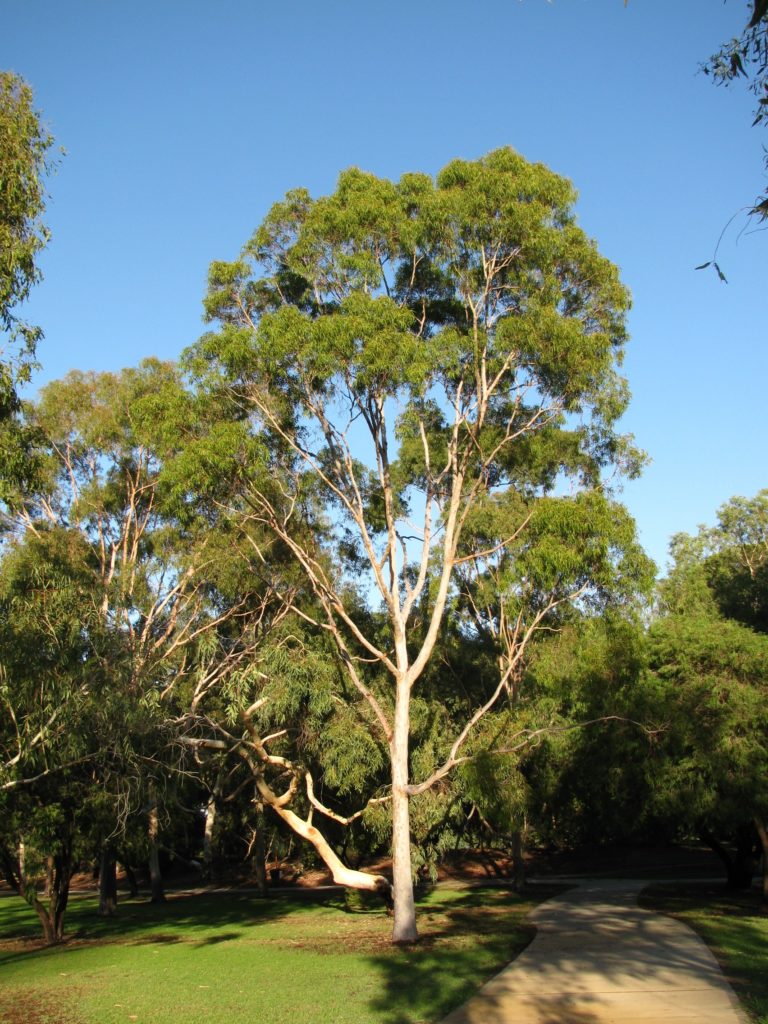
Corymbia citriodora subspecies citriodora is a native of north Queensland in Australia but is grown throughout the subtropics for essential oil production. (Photo by Mervyn Shepherd)
Genome annotations of two C. citriodora subspecies broaden understanding of the terpene synthase gene family across eucalypt lineages.
The Science
From the distinct smell of eucalyptus to the flavor of wine, terpenes are ubiquitous. A diverse group of plant-produced organic compounds, terpenes play key roles in plant growth, defense, and environmental interactions. Terpenes are also economically important because of their use in industrial materials, pharmaceutical products, and as biofuel precursors. Collectively, hundreds of terpene compounds have been characterized from eucalypts, a group of 900 tree species belonging to the Myrtaceae (myrtle) family and containing the closely-related genera Angophora, Corymbia and Eucalyptus.
The Impact
The genus Corymbia is endemic to northern Australia but is increasingly farmed in other countries for essential oil production. The recent assembly of two Corymbia citriodora subspecies variegata genomes allowed researchers to study the conservation and evolution of the genes responsible for terpene synthase (TPS) enzyme production. This family of enzymes is critical to the synthesis and broad diversity of terpenes. Until recently, studies of the TPS gene family were confined to two Eucalyptus species, E. grandis and E. globulus. The annotation of two C. citriodora subspecies provides an excellent opportunity to investigate the conservation and evolution of this important gene family across eucalypt lineages. Since terpenes serve as feedstocks for biofuel production, a greater understanding of terpene synthesis in plants will be important for alternative fuel development in the future.
Summary
Though the closely-related Eucalyptus and Corymbia species number among the eucalypts, they inhabit different environments. Eucalyptus species prefer cooler, more temperate or sub-tropical environments, while Corymbia are more abundant in the drier parts of Australia with lower quality soils and even in the desert areas with poor rainfall. That said, Corymbia can also thrive in areas that receive a lot of rain. Previous analysis of the E. grandis reference genome, an international effort by a team that included researchers at the DOE Joint Genome Institute, a DOE Office of Science User Facility, revealed the largest number of TPS genes of any currently sequenced plant, a number closely followed by E. globulus. Occurring in clusters or duplicate arrays, these genes are prone to rapid genetic expansion which partially explains the great variety of terpene products in nature. As part of a proposal by the DOE’s Joint BioEnergy Institute (JBEI), the JGI worked on resequencing several eucalypt genomes to establish the feasibility of genome wide association studies for genetic traits that are desirable from a biofuels production perspective. By using genomic database alignment tools, researchers searched for TPS genes in C. citriodora. They then compared the list of putative genes from C. citriodora to known TPS gene sequences from Eucalyptus species and other plants. The locations of TPS genes and gene clusters were mapped against those of E. grandis to find differences in genome organization between the two species. The work was reported in the journal Heredity.
In order to understand the gene expression and function of these TPS genes, Australian researchers sequenced mRNA from different tissues of C. citriodora. From these samples, a total of 127 TPS loci were found, many of which had high sequence similarity to TPS genes from other plants. Researchers reported 102 total putative functional TPS genes in C. citriodora, which is high compared to other plants, and comparable to the number of TPS genes in E. grandis. Notably, the specific types of TPS genes found in C. citriodora suggest that these plants synthesize a high level of secondary metabolites which play a part in biotic and abiotic stress responses.
Overall, this study improves our understanding of the terpene synthase gene family and shows us that a large TPS gene family is well-conserved across eucalypts. Improved knowledge of the evolution and selection of this gene family may help researchers manipulate TPS genes to increase terpene production for biofuel development.
Contacts
Daniel Drell, Ph.D.
Program Manager
Biological Systems Sciences Division
Office of Biological and Environmental Research
Office of Science
US Department of Energy
daniel.drell@science.doe.gov
Jeremy Schmutz
Plant Program Head
DOE Joint Genome Institute
jschmutz@hudsonalpha.org
Funding
This work was supported by the Australian Research Council (grant numbers DP140102552, DP110101621), and an Australian Government Research Training Program Scholarship. Sequencing and assembly data carried out by EMBRAPA as part of the Corymbia genome project was supported by FAPDF grant “Nextree” 193.000.570/2009. For the portion of the work conducted by the Joint Genome Institute and the Joint BioEnergy Institute, support was provided by the Office of Science of the U.S. Department of Energy under Contract No. DE-AC02-05CH11231.
Publication
- Butler JB et al. Annotation of the Corymbia terpene synthase gene family shows broad conservation but dynamic evolution of physical clusters relative to Eucalyptus. 2018 Jul;121(1):87-104. doi: 10.1038/s41437-018-0058-1.
Related Links:
- JGI news release on eucalyptus genome: https://jgi.doe.gov/just-food-koalas-eucalyptus-global-tree-fuel-fiber/
- Eucalyptus genome on Phytozome: http://bit.ly/Phytozome-Eucalyptus
- Video of Jerry Tuskan, ORNL scientist and CABBI CEO, on implications of Eucalyptus genome analysis: http://bit.ly/eucalyptusTuskan